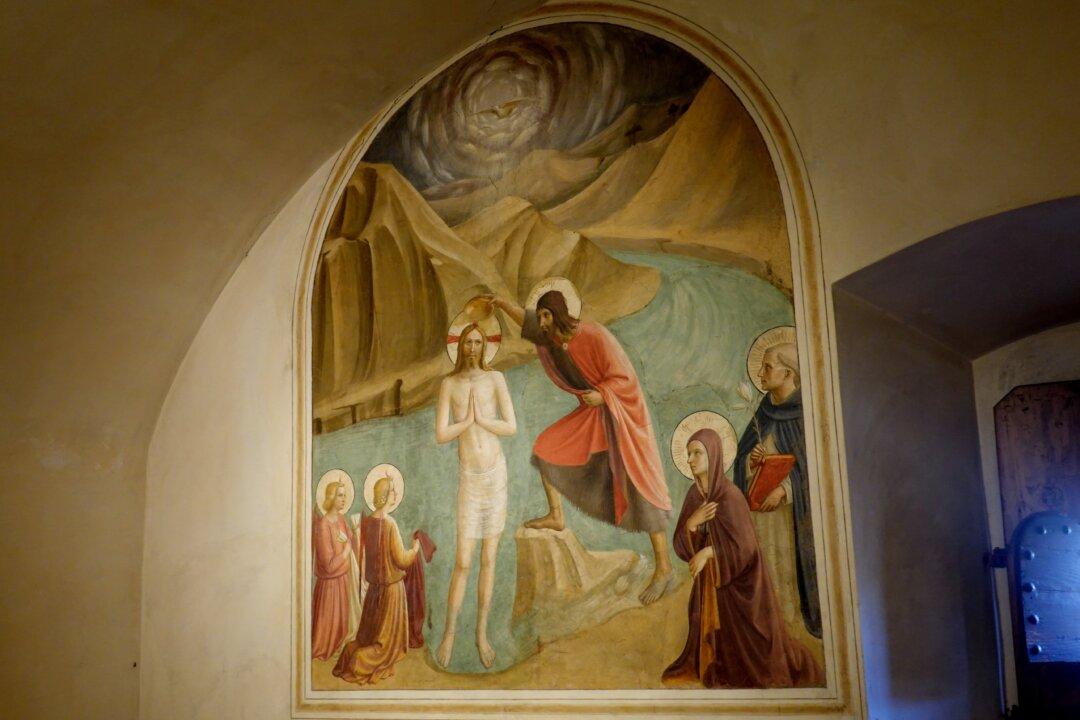In San Marco Convent in Florence, Italy, art helped mediate Dominican monks’ communion with the spiritual realm. In communal spaces and in their private dormitories, friars would meditate on frescoes depicting scenes from the life of Christ. As a monk’s spiritual contemplation deepened, frescoes of increasing complexity became available for his contemplation.
According to Giorgio Vasari’s famous series of artist biographies, “The Lives of the Most Excellent Painters, Sculptors, and Architects,” in 1437, Cosimo de’ Medici the Elder, a prominent Italian banker and politician, invested some 40,000 florins to renovate the convent to suit Renaissance sensibilities. In Medici’s time, a single florin could support a frugal person for a month.

Gradations of Spiritual Awakenings
San Marco’s frescoes played a role in Dominican meditation practices, leading the monks to deepen their spiritual engagement through contemplation.
On the second floor of the convent were dormitory cells where the friars slept. Each cell was adorned with a different image depicting a scene from the life of Christ meant to evoke meditation, prayer, and devotion. Aside from the single frescoed image gracing a wall in each cell, the friars’ dormitories were plain and sober; the remaining walls are of humble whitewashed plaster.
The frescoed images varied in spiritual and intellectual complexity. Simpler images were meant to be contemplated by the junior friars while the more sophisticated images were meant to be meditated upon by the senior friars.
The Annunciation

The cloister-like architecture in which the scene takes place mirrors the friars’ own setting at San Marco, bridging the past and the present. It underscores the idea that spiritual ascent begins in everyday reality.
The Transfiguration of Christ

In “Transfiguration,” Jesus brings Peter, James, and John up to the summit of Mount Tabor, where he is transfigured before them. This scriptural event is recorded in Matthew 17:1-8. In it, Jesus’s face is described as shining and his clothing bright.
The apostles fall to the ground and are portrayed kneeling at Jesus’s feet in a state of fear and awe—a state that the Dominican friars (depicted in the composition’s middle register) participated in through prayer and contemplation. James and John are shielding their eyes and recoiling, symbolizing the human struggle to grasp higher divine realities. Their mixed reactions of reverence, fear, and confusion mirror the soul’s spiritual ascent toward enlightenment.
Just beneath Christ’s outstretched arms are the flanking heads of Moses and Elijah, heavenly witnesses to the glorious scene, representing the Law of the Old Testament and the Prophets respectively.
‘Noli Me Tangere’

While Christ is revealed in “The Transfiguration,” he is still within time. In “Noli Me Tangere,” Mary Magdalene kneels in awe in front of the risen Christ, now a glorified being beyond time and physical grasp, a scriptural event recorded in John 20:17. The composition is bathed in soft light. In a gesture of blessing and command, Jesus turns away from Mary Magdalene as she reaches to touch him. “Noli Me Tangere” thus signifies a complete spiritual transformation where the soul transcends earthly perception and seeks full communion with Christ.
Scattered across the verdant ground are tiny scarlet flowers, which art historian Georges Didi-Huberman believed symbolized “little incarnate blotches … of Christ’s blood.” Indeed, Fra Angelico used the same “terra rosa” color—a pigment composed of minuscule silicate fragments, the textural qualities of which evade photographic capture—to paint Christ’s blood in “The Crucifixion” and the flowers in “The Annunciation” and “Noli Me Tangere.”
“Hence, the red flowers scattered in this spring garden trace something like a dotted line leading from the Fall—the flowers in the lost Eden—to the Incarnation, and from the Incarnation to the redemptive sacrifice: flowers of martyrdom. … His blood soaks the earth and makes a new humanity grow there, a humanity in the imitation of Christ, a humanity redeemed from sin,” wrote Didi-Humberman in his monograph “Fra Angelico: Dissemblance and Figuration.”
Fra Angelico’s fresco invites the contemplative monk to meditate on the intangible nature of spiritual transformation. Mary Magdalene desires a relationship with Jesus. Her yearning for closeness is expressed in her effort to touch the risen Christ. However, Christ’s refusal to allow her to touch him reminds viewers that true relationship with God transcends physical forms. It is deepened through faith, prayer, and contemplation.
As a result, the friar is called to detach from physical desires and all earthly attachments, and to embrace instead a spiritual resurrection of the soul.
“I looked long; one can hardly do otherwise. The fresco deals with the pathetic on the grand scale, and after taking in its beauty you feel as little at liberty to go away abruptly as you would to leave church during the sermon. You may be as little of a formal Christian as Fra Angelico was much of one; you yet feel admonished by spiritual decency to let so yearning a view of the Christian story work its utmost will on you.”








